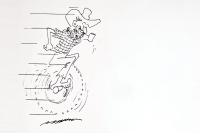Painted Horses is one for the ages
 When people ask me what I’ve been doing this fall, I tell them I’ve been on a reading jag — reading new novels hot off the press. What I’ve found is that there have been a lot of very good books that have come out in the last year, including some by some very talented new writers who are just coming on the scene.
When people ask me what I’ve been doing this fall, I tell them I’ve been on a reading jag — reading new novels hot off the press. What I’ve found is that there have been a lot of very good books that have come out in the last year, including some by some very talented new writers who are just coming on the scene.
Books that I’ve read and recommend so far this fall include The Book of Strange New Things, by David Mitchell;, Zealot: The Life and Times of Jesus of Nazareth, by Reza Aslan (a book of non-fiction written like fiction); All the Light We Cannot See, by Anthony Doerr; Station Eleven, by Emily St. John Mandell; Orkney, by Amy Sackville; Orfeo, by Richard Powers; and then all the while dipping into the Collected Stories of Carson McCullers and Flannery O’Connor for a little historical perspective.
But maybe the best of all of these new novels and new writers is a brand new book by Malcolm Brooks titled Painted Horses.
The book is a combination of war story, art history, cultural anthropology and archeological history of Europe and Native America, mystery/thriller, environmental activism, and a romance novel — all of which is poetically written in explicit detail and marvelous description. The research, alone, for this book must have taken Brooks half a lifetime, so right-on is his factual knowledge of all these places and subjects, which extends to and includes some perfect French that he utilizes at the end of the book.
Painted Horses takes place in the 1950s when the west was still very much wild. Catherine Lemay is a young archeologist who has come for the first time to Montana with a job that has her working ahead of a major dam project and who has only one summer to prove nothing of historical value will be lost in the flood that will inundate a huge canyon. John H is a former mustanger with an intuitive genius for breaking horses and a veteran of the U.S. Army’s last mounted cavalry campaign in WWII. He lives a fugitive life deep in the canyon and one step ahead of extinction, but driven by pursuit of one last wild thing.
Driven by his past and his quiet wisdom, he inspires Catherine to see beauty in the stark Montana landscape as her heart opens to more than just the vanished past. These two are surrounded by characters who will become friends and adversaries as Indian and Anglo traditionalists are pitted against a ruthless mega power company called Harris Power & Light to try and preserve an ancient and sacred landscape and its millennia-old relics. What starts for Catherine and her new Crow Indian friend Miriam as a fact-finding field trip into the desert, by the book’s end has become a cloak-and-dagger tale of intrigue and lethal capitalistic politics. A love story that becomes a horse race that becomes a cliff-hanger with lives and loves and ancient artifacts on the line.
Related Items
But the best way to describe a story is in the words of the storyteller himself.
“He knew of monuments left by people whose wanderings had long ceased, messages pregnant with lost meaning, shields and symbols etched into the stone face of a jump or rendered in fading paint on the wall of an overhang. Arrows, chevrons. Palm prints from hands long ago. He’d studied chips of flint scattered in the sand like shards of memory itself, tea leaves testifying to long-lost arts. The coaxing of a tool from a stone, lethal and beautiful and truer for the both. A blade, a notched point. He had many things to show her.”
During the course of this engaging saga, Brooks takes us from Montana to London, to the second World War in Spain and Italy, to a Lascaux-like cave in Brittany, to Paris, and back again. “What a ride!” would be the perfect metaphor for a book about a horse wrangler who follows the herds of wild horses on the western plains. Brooks’ main character John H is not only a horseman but also an artist who paints — you guessed it — horses. As Brooks describes him: “He experiments, more than once painting figures [of horses] across her abdomen, across her back, over the ridges and flutes of her ribs. Her belly button becomes an eye, her shoulder blade a forequarter.”
All the while and with The Rolling Stones’ “wild horses, wild horses, couldn’t take me away…” running through my head and reminiscent of Larry McMurtry’s and Jim Harrison’s tales of wild horses and the far western Badlands of the U.S., Painted Horses did take me away and right into the thick of the story and its characters. It is the quality of the writing that does this and which transported me there like an H.G. Wells time-machine.
“Who would a person love. When would death knock. Mysteries like the wheels of a gear regulated in turn by wars and invasions, earthquakes and famines. In the end the magic of being alive was both created and destroyed by a velocity not perceived but present, each lifetime hurtling toward a light so bright you could but glance before you were forced not only to look away but to forget you ever saw it, for meaning itself was no more than a cipher within that light.”
Brooks is also a master at using such poetic devices as metaphor and simile. The text is full of them — always pithy, always poignant. Like shards and flint-points from an archeological dig, Brooks’ associative mind is working overtime:
“John H does not speak French well enough to follow their conversation, which whirls and flashes like a festival, but he gathers she loves to argue, her tongue quick as a matador’s cape,” Or “Her nerves felt like a shoelace that wouldn’t stay tied.” or “… something beyond a fin or bare stone breaching the sage along the river like the keel of a capsized boat.”
And in another slightly longer passage:
“The low ceiling undulates in shallow white domes, as though the four of them have been inhaled down the trachea of a giant. At times he’s nearly disoriented, the shadow of the cave and the endless dancing animals bending his brain like the lick of a gas. Eventually, he tries to speak and nothing comes out. He can’t get his tongue to touch the roof of his mouth, can barely get the muscles of his jaw to pry his lips apart, as though paralyzed in a dream in which he should be running for his life.”
There are these kinds of engaging descriptions throughout this book. Lots of great one-liners that one would be tempted to lift for one’s own purposes to insert into the makings of one’s own poems. But I digress, for along with the extraordinary one-liners there are also passages of beautiful simplicity and depth.
“Two men loaf in identical black berets and identical work smocks, smoking identical cigarettes, and although probably forty years separate them John H has the disorienting sense he is seeing twins of a sort, or perhaps parallel incarnation of the same beast, unified in spirit yet separated by the long crawl of time.”
But when everything’s said and done and even though the love story takes the fewest pages to play out, it is that story which predominates and which one is left with, lingering in one’s mind:
“She wanted to know everything. She wanted to hear his voice, to keep him talking. In the glow of the lamp she could just see the stack of canvases against the wall, and she saw more than horses. She saw a blur of poppies on a damp green field, a city at night, a horizon of lights that reminded her of The Great Gatsby. She had a greedy urge to rifle the entire stack, imagined herself alone with his things, a thief of secrets. She wanted to piece him together like a puzzle. She was torn between two ends of a mystery, wanting to solve it on one hand, seduced on the other by things she didn’t know.”
Thomas Crowe is the author of the award-winning nature memoir Zoro’s Field: My Life in the Appalachian Woods and writes editorials and reviews for this paper. He lives in Tuckasegee and can be reached at This email address is being protected from spambots. You need JavaScript enabled to view it..
Painted Horses by Malcolm Brooks. Grove Press, 2014. 367 pages.









